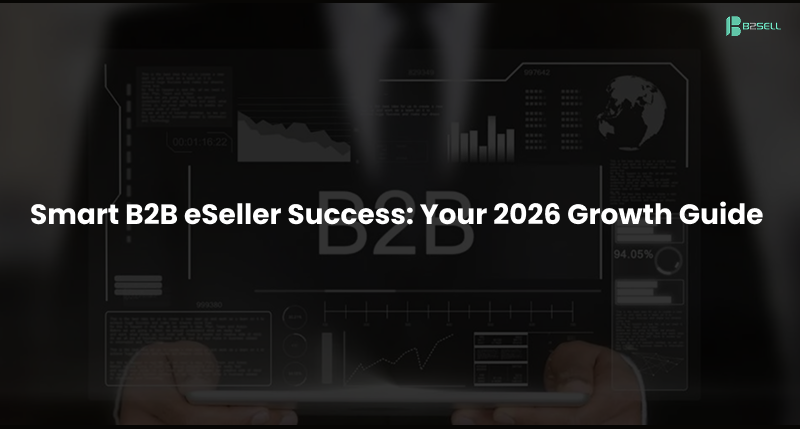The B2B ecommerce field is changing quickly. Gone are the days of outdated technologies and manually driven processes. Exodus from the old way of doing business to more exciting avenues is necessitated by rapidly shifting client preferences, all the while opening opportunities for operational efficiency. For Epicor P21 ERP users, adopting an advanced B2B ecommerce platform is clearly, then, not just a fanciful undertaking but a must for sustainable growth and competition.
This guide outlines the top 10 must-have B2B ecommerce features for P21 in 2025 and provides a step-by-step approach to getting started with B2Sell, a leading B2B ecommerce solution designed specifically for P21 users.
Why B2B Ecommerce is Critical for P21 Users in 2025 ?
Before mentioning the features, let us know why a strong B2B ecommerce platform is essential for P21 users in the years to come.
- Meeting New-Evolutionary Customer Expectations: B2B buyers would demand a seamless, personalized, and self-service experience in the B2B world that at present is nothing but an extension of the B2C characteristics.
- Expanding Market Reach: Ecommerce opens new markets and customer segments, allowing you to transcend geographical limitations.
- Operational Efficiency: The introduction of automation within sales processes, including order management and customer fulfillment, lessens manual effort while also acting to lower operational costs.
- Competitive Advantages: A dynamic B2B ecommerce platform allows differentiation from the competitors and therefore offers greater client experience.
- Data-Driven Decisions: The insight into consumer behavior, product success, and market trends that ecommerce platforms can give empowers management with the tools to make data-driven decisions.
Top 10 Must-Have B2B Ecommerce for P21 Features in 2025
Here are the 10 features that will prove to be crucial for B2B ecommerce success within the P21 in 2025, going forward:

1. Real-Time P21 Integration:
- Description: A unified and bi-directional synchronization with P21 is the basis of an effective B2B ecommerce strategy, including live updates of stock levels, pricing, customer-specific discounts, order status, and account information.
- Why it's critical: It cuts data silos, helping ensure correctness while presenting customers with live data to limit frustrations and errors in their orders.
- Features to consider: Automated data synchronization, API-based integration, custom field mapping, a nympho dimension in ability for error-handling capacities featuring automated data synchronization; API-based integration; custom field mapping; error-handling abilities.
2. Personalized Customer Experiences:
- Description: It is critically important that every ecommerce experience be effusively customized to every customer need and preference, such as individualized product picks, giant pricing, content, and promo offers based on sales history, account types, and more.
- Why it's critical: Enhanced customer engagement, increased margins, and longer-lasting relationships.
- Functionality to look for: Customer segmentation, products catalogs personalization, dynamic pricing rules, targeted couponing.
3. Advanced Search and Filtering:
- Description: Since B2B catalogs can be fairly immense, it is decisive to provide them with good search and filtering capabilities. So this means, for example, advanced search algorithms; faceted navigation; parametric search; searching may include several categories: part number; description; and attributes.
- Why it's critical: It enables customers to easily find the needed products quickly; if they cannot find them quickly, expectations for purchase also reduce.
- Functionality to look for: Consider the possibility of having predictive search; synonym management; adamancy filtering; and visual search.
4. Self-Service Account Management:
- Description: Customer self-reporting via online account management reduces the load on your customer support team while also boosting customer satisfaction features: Seen examples of web-based order history or invoice management, payment options, address book, and user management.
- Why it's critical: Increases customer autonomy, reduces support requests, and streamlines account management processes.
- Functionality to look for: Online payment options, credit limit management, invoice downloads, and user role management.
5. Mobile-First Design and Optimization:
- Description: With the increasing number of mobile devices used in B2B transactions, thus a necessity arises for mobile-first design. In other words, a design that is responsive to a variety of devices/screen sizes, optimized for mobile device performance, and endowed with mobile-specific features.
- Why it's critical: Because growing mobile workforce accessibility it smoothens transitions across devices.
- Functionality to look for: Responsive design, Mobile-optimized checkout, Mobile-specific content.
6. Enhanced Content Management System (CMS):
- Description: A user-friendly CMS allows you to easily create and manage engaging content, including product descriptions, marketing materials, and educational resources.
- Why it's critical: Improves product discoverability, heightens shopping experiences, and empowers your market-facing activities.
- Functionality to look for: Drag-and-drop content editor, SEO optimization tools, Integration with marketing automation platforms.
7. Quote and Approval Management:
- Description: B2B transactions generally involve some complex pricing structures and multi-level approval workflows; thus, the e-commerce platform must support quote requests, custom pricing, and multi-level approval processes.
- Why it's critical: Streamlines quoting, ensures accuracy of pricing, and allows for efficient order processing.
- Functionality to look for: Quote request forms, Custom pricing rules, Role-based approval workflows.
8. Integrated Shipping and Logistics:
- Description: Seamless integration with shipping carriers and logistics providers simplifies order fulfillment and enables accurate shipping information to be available to customers.
- Why it's critical: Reduces shipping errors, improves shipping times, and enhances customer satisfaction.
- Functionality to look for: Real-time shipping rate calculations, Order tracking for all shipments, Integrations with major shipping carriers.
9. Advanced Analytics and Reporting:
- Description: Their rich analytics and reporting capabilities provide invaluable insights about customer behavior, product performance, and website efficiency.
- Why it's critical: It allows data-driven decision making, areas of improvement identification for the eCommerce strategy optimization.
- Functionality to look for: Sales dashboard, customer segmentation, product performance evaluation, and tracking conversion rates.
10. Robust Security Measures:
- Description: Effectively protecting sensitive customer data while making sure that transactions are secure should be a top priority.
- Why it's critical: It fosters customer confidence, shields your business against cyber threats, and keeps you in check with industry regulations. Functional Requirements; SSL encryption, PCI compliance, fraud detection, and data breach prevention.
- Functionality to look for: SSL encryption, PCI compliance, and a variety of fraud prevention tools are just some examples.
Getting Started with B2Sell B2B Ecommerce for P21: A Step-by-Step Guide
Step 1: Assessment and Planning:
- Define Your Goals: You must define your specific objectives in order to implement B2B ecommerce. What are you trying to achieve in terms of sales growth, satisfaction for customers, and operational efficiencies?
- Identify Your Target Audience: You need to understand what your target audience looks like, their needs, wants, and preferences. What do they require from a B2B ecommerce experience?
- Analyze Your Existing P21 Data: Evaluate the completeness and quality of your existing P21 data; that includes customer information, product catalogs, and pricing rules.
- Develop a Project Plan: Develop a detailed plan for the project that contains timelines, milestones, and who will take on specific responsibilities in detail.
Step 2: B2Sell Implementation:
- Contact B2Sell: Reach Out to B2Sell team and speak on your needs and requirements.
- Systems Configuration: Work Together with B2Sell Team to Configure the Platform to Match Your Specific Business Processes and P21 Settings Collectively; This would include bringing about configuration regarding data synchronization, pricing rules, and user roles.
- Design and Customization: Customize the look and feel of your B2B ecommerce website to align with your brand identity.
- Data Migration: Migrate your relevant data from P21 into B2Sell, ensuring that the data is accurate and inaccessible.
Step 3: Testing and Training:
- Exhaustive Testing: Perform extensive testing of every aspect and function of the system to ensure they're all operating perfectly.
- Training Users: Train your staff fully in using the B2Sell site.
- Training Customers (Optional): Provide customers with training in utilizing the new B2B online store.
Step 4: Launch and Promotion:
- Go Live: Launch your B2B ecommerce site and make an announcement to your customers.
- Promote Your Site: Promote your site actively through email marketing, social media, and other means.
- Get Feedback: Get feedback from your customers and employees to determine areas of improvement.
Step 5: Ongoing Optimization and Maintenance:
- Track Performance: Regularly track the performance of your B2B ecommerce site and monitor key metrics.
- Implement Updates: Update the B2Sell platform periodically with new features and security patches.
- Optimize Your Website: Optimize your website on a continuous basis based on customer feedback and data analysis.
Conclusion
By adopting these top 10 B2B ecommerce features and the step-by-step guide to launching B2Sell, P21 users can set themselves up for success in the fast-changing B2B environment. By adopting these features, companies can optimize operations, improve customer experiences, and generate tremendous revenue growth in 2025 and beyond. Don't forget to make real-time P21 integration, personalized experiences, and strong security features a top priority to create a successful B2B ecommerce presence.
Get in touch with our team to start your free demo today!







.png)